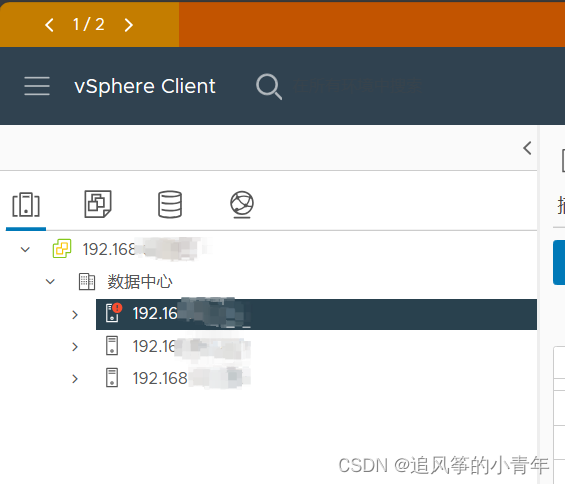1.整理vsphere中的虚拟机资源
将每一台虚拟主机所属esxi主机,虚拟机电源状态,虚拟主机ip,虚拟机的操作系统,虚拟所属文件夹,虚拟机的备注一一对应,存放到xlsx表格。
其中vsphere的目录为:

from pyVim.connect import SmartConnect, Disconnect
from pyVmomi import vim
from openpyxl import Workbook
import ssl
def connect_to_vcenter(host, user, pwd):
try:
# Disable SSL certificate verification
ssl_context = ssl.SSLContext(ssl.PROTOCOL_TLS)
ssl_context.verify_mode = ssl.CERT_NONE
# Connect to vCenter server
service_instance = SmartConnect(host=host, user=user, pwd=pwd, sslContext=ssl_context)
return service_instance
except Exception as e:
print(f"Error connecting to vCenter: {str(e)}")
return None
def disconnect_from_vcenter(service_instance):
try:
if service_instance:
Disconnect(service_instance)
except Exception as e:
print(f"Error disconnecting from vCenter: {str(e)}")
def get_vm_info(service_instance):
vm_info = []
content = service_instance.RetrieveContent()
container = content.rootFolder # Root folder for searching
viewType = [vim.VirtualMachine] # Type of object to search for
recursive = True # Search recursively
containerView = content.viewManager.CreateContainerView(container, viewType, recursive)
for vm in containerView.view:
vm_object = {
"虚拟机名": vm.name,
"所属ESXi主机": vm.runtime.host.name,
"虚拟机电源状态": vm.runtime.powerState,
"虚拟机IP": vm.guest.ipAddress,
"虚拟机操作系统": vm.summary.config.guestFullName,
"虚拟机所属文件夹": vm.parent.name,
"虚拟机备注": vm.config.annotation
}
vm_info.append(vm_object)
containerView.Destroy()
return vm_info
def export_to_excel(vm_info, file_path):
wb = Workbook()
ws = wb.active
ws.append(["虚拟机名", "所属ESXi主机", "虚拟机电源状态", "虚拟机IP", "虚拟机操作系统", "虚拟机所属文件夹", "虚拟机备注"])
for vm in vm_info:
ws.append([vm["虚拟机名"], vm["所属ESXi主机"], vm["虚拟机电源状态"], vm["虚拟机IP"], vm["虚拟机操作系统"], vm["虚拟机所属文件夹"], vm["虚拟机备注"]])
wb.save(file_path)
print(f"虚拟机信息已导出到 {file_path}")
if __name__ == "__main__":
vcenter_host = "192.168.x.x" #也可以是域名。比如:vcsa.test.com.cn
vcenter_user = "test@vsphere.local"
vcenter_pwd = "Ttttttt123_"
output_file = "C:\\Users\\111\\Desktop\\rules\\虚拟机信息.xlsx" #存放路径
# Connect to vCenter
service_instance = connect_to_vcenter(vcenter_host, vcenter_user, vcenter_pwd)
if service_instance:
# Get VM information
vm_info = get_vm_info(service_instance)
# Export to Excel
export_to_excel(vm_info, output_file)
# Disconnect from vCenter
disconnect_from_vcenter(service_instance)
else:
print("Failed to connect to vCenter.")
运行后的结果:

2.批量开关机虚拟主机
当需要批量去开关某个项目的虚拟机时,可以有一定的作用。可以优化的地方,将虚拟机名放到一个文本文件中
# 定义要操作的虚拟机名称列表
vm_names = ["test-99.23", "test-99.20"]
# 连接到 vCenter
# 在 Python 中需要使用适当的库来连接到 vCenter,这里假设使用 pyvmomi 库
from pyVim import connect
from pyVmomi import vim
import ssl
# 忽略 SSL 证书验证错误
ssl._create_default_https_context = ssl._create_unverified_context
# 连接到 vCenter
def connect_to_vcenter(host, user, password):
try:
service_instance = connect.SmartConnect(host=host, user=user, pwd=password)
return service_instance
except Exception as e:
print("无法连接到vCenter:", str(e))
return None
# 主程序
def main():
vcenter_host = "192.168.x.x" #也可以是一个域名
vcenter_user = "test@vsphere.local"
vcenter_password = "test"
service_instance = connect_to_vcenter(vcenter_host, vcenter_user, vcenter_password)
if not service_instance:
return
# 显示菜单以供用户选择操作
print("请选择要执行的操作:")
print("0. 关机")
print("1. 开机")
print("2. 重启")
# 获取用户选择的操作
choice = input("请输入选项的编号: ")
# 根据用户选择执行相应的操作
if choice in ["0", "1", "2"]:
# 对每个虚拟机执行相同的操作
for vm_name in vm_names:
try:
vm = None
container = service_instance.content.rootFolder
viewType = [vim.VirtualMachine]
recursive = True
containerView = service_instance.content.viewManager.CreateContainerView(container, viewType, recursive)
for managedEntity in containerView.view:
if managedEntity.name == vm_name:
vm = managedEntity
break
if vm:
if choice == "0":
if vm.runtime.powerState == vim.VirtualMachinePowerState.poweredOn:
vm.PowerOff()
print(f"虚拟机 {vm_name} 已关机。")
else:
print(f"虚拟机 {vm_name} 已经是关机状态。")
elif choice == "1":
if vm.runtime.powerState == "poweredOff":
vm.PowerOn()
print(f"虚拟机 {vm_name} 已开机。")
else:
print(f"虚拟机 {vm_name} 已经是开机状态。")
elif choice == "2":
vm.Reset()
print(f"虚拟机 {vm_name} 已重启。")
else:
print(f"无法找到虚拟机 {vm_name}")
except Exception as e:
print(f"无法执行操作 {choice} 对虚拟机 {vm_name}: {str(e)}")
else:
print("无效的选项,请重新运行脚本并输入正确的选项编号。")
# 断开与 vCenter 主机的连接
connect.Disconnect(service_instance)
if __name__ == "__main__":
main()